Page 145 of 230

0 co ......
"' ,....
"' ...... 0 0 :::,
00
use the safety belt height adjustment to help
adjust the shoulder portion properly .
~ Secure unused safety belts on the rear seat
¢ page 139.
Children up to at least 8 years old (over 40 lbs. or
18 kg) are best protect ed in child safety s eats de
signed for their age and weight. Experts say that
the skeletal structure, particularly the pelvis, of
these children is not fully developed, and they
must not use the vehicle safety belts without a
suitable child restra int .
It is usually best to put these children in appro priate booster seats . Be sure the booster seat
meets all applicable safety standards .
Booster se ats raise the seating position of the
child and reposition both the lap and shoulder
parts of the safety belt so that they pass across
the child's body in the right places. The rout ing of
the belt over the child's body is very important
for the child's protection, whether or not a boos
ter seat is used. Chi ld ren age 12 and unde r must
a lways ride in the rear seat .
Ch ildren who are at least 4 ft . 9 in. (57 inches/
1.45 mete rs) tall ca n genera lly use the veh icle's
three po int lap and shoulder be lts. Neve r use the
l ap belt po rtion of the vehicle 's safety belt alone
to restrain any child, regardless of how big the
chi ld is. A lways remember that children do not
hav e the pronounced pelvic structure required for
the proper function of lap belt port ion of the ve
h icle 's three point lap and shoulder be lt s. The
chi ld 's safety absolutely requires that a lap belt
port ion of the safety belt be fastened snugly and
as low as possible around the pelvis . Never let
the lap belt portion of the safety belt pass over
the child's stomach or abdomen.
In a crash, a irbags must inflate within a blink of
an eye and wit h considerable force . In order to do
its job, the airbag needs room to inflate so that it
will be there to p rotect the occupant as the occu
pant moves forward into the a irbag.
A vehicle occupant who is out of position and too
close to the airbag gets in the way of an inflating
ai rbag. When an occ upant is too close, he o r she
will be struck v iolently and will receive ser ious or
possibly even fatal injury.
Ch ild safety
In order for the a irbag to offer protection, it is
important that a ll vehicle occupants, especially
any ch ildren, who m ust be in the front seat be
cause of exceptiona l circumstances, be properly
res tra ined and as far away from the airbag as
poss ible. By keeping room between the child 's
body and the front of the passenger compart
ment, the a irbag can inflate completely and pro
vide s upplementa l protec tion in certain frontal
collisions.
A WARNING
-
Not using a booster seat, using the booster
seat improperly, incorrect ly installing a boos
ter seat or using the vehicle safety belt im
properly increases the risk of serious personal
i njury and death in a collision or other emer
gency situation. To help reduce the risk of se rious personal injury and/or death:
- The shou lder belt must lie as close to the
center of the ch ild's collar bone as possible
and must lie flat and snug on the upper
body. It must never lie across the throat or
neck. The lap belt must lie ac ross the pelvis
and never across the stomach o r abdomen.
Make sure the bel t lies flat and sn ug. Pu ll on
the belt to tighten if necessary.
- Fail ure to properly route safety bel ts over a
child's body w ill cause severe injuries in an
accident or other emergency situation
¢ page 106.
- The rear side of the chi ld safety seat should
be positioned as close as possible to the
backrest on the vehicle seat. Adjust or re
move the rear seat head restraint if it is dif
f icult to insta ll the ch ild seat with the head
restraint in place¢
page 44 . Install the
head restraint again immed iately once the
child seat is removed . Driving without head
rest raints or with head restra ints that a re
not properly adj usted increases the r is k of
serio us or fatal ne ck in jury dramatically .
- Never let a chi ld put the shoulder belt under
the arm or behind the ba ck, because i t could
cause severe inj uries in a crash .
- Ch ild ren on the fron t seat of any car, even
with Advanced Airbags, can be seriously in-
jured or even ki lled when an airbag inflates .
Ill>
143
Page 146 of 230
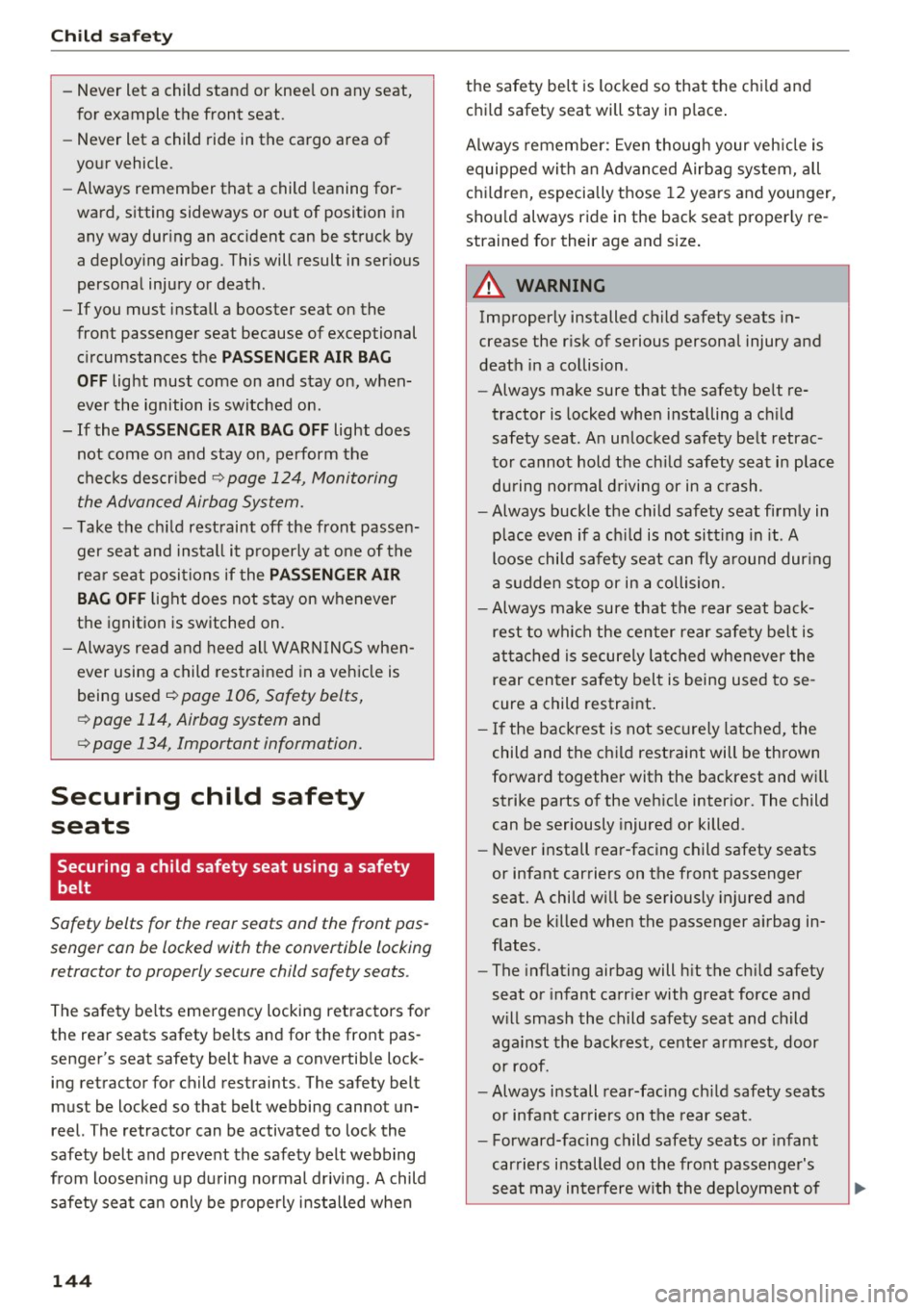
Child safety
-Never let a child stand or kneel on any seat,
for example the front seat.
- Never let a child ride in the cargo area of
your vehicle.
- Always remember that a child leaning for
ward, sitting sideways or out of position in
any way during an accident can be struck by
a deploying airbag. This will result in serious
personal injury or death.
- If you must install a booster seat on the
front passenger seat because of exceptional
circumstances the
PASSENGER AIR BAG
OFF
light must come on and stay on, when
ever the ignition is switched on.
- If the
PASSENGER AIR BAG OFF light does
not come on and stay on, perform the
checks described
Q page 124, Monitoring
the Advanced Airbag System.
- Take the child restraint off the front passen
ger seat and install it properly at one of the
rear seat positions if the
PASSENGER AIR
BAG OFF
light does not stay on whenever
the ignition is switched on.
-Always read and heed all WARNINGS when
ever using a child restrained in a vehicle is
being used
Q page 106, Safety belts,
Q page 114, Airbag system
and
Q page 134, Important information.
Securing child safety
seats
Securing a child safety seat using a safety
belt
Safety belts for the rear seats and the front pas
senger can be locked with the convertible locking
retractor to properly secure child safety seats .
The safety belts emergency locking retractors for
the rear seats safety belts and for the front pas
senger's seat safety belt have a convertible lock
ing retractor for child restraints. The safety belt
must be locked so that belt webbing cannot un
reel. The retractor can be activated to lock the
safety belt and prevent the safety belt webbing
from loosening up during normal driving. A child
safety seat can only be properly installed when
144
the safety belt is locked so that the child and
child safety seat will stay in place.
Always remember : Even though your vehicle is
equipped with an Advanced Airbag system, all
children, especially those 12 years and younger,
should always ride in the back seat properly re
strained for their age and size.
A WARNING
Improperly installed child safety seats in
crease the risk of serious personal injury and
death in a collision .
-
-Always make sure that the safety belt re
tractor is locked when installing a child
safety seat. An unlocked safety belt retrac
tor cannot hold the child safety seat in place
during normal driving or in a crash.
- Always buckle the child safety seat firmly in
place even if a child is not sitting in it. A
loose child safety seat can fly around during
a sudden stop or in a collision.
- Always make sure that the rear seat back
rest to which the center rear safety belt is
attached is securely latched whenever the
rear center safety belt is being used to se
cure a child restraint.
-If the backrest is not securely latched, the
child and the child restraint will be thrown
forward together with the backrest and will strike parts of the vehicle interior. The child
can be seriously injured or killed .
- Never install rear-facing child safety seats
or infant carriers on the front passenger
seat. A child will be seriously injured and
can be killed when the passenger airbag in
flates.
- The inflating airbag will hit the child safety
seat or infant carrier with great force and
will smash the child safety seat and child
against the backrest, center armrest, door
or roof.
-Always install rear-facing child safety seats
or infant carriers on the rear seat.
- Forward-facing child safety seats or infant
carriers installed on the front passenger's
seat may interfere with the deployment of
Page 147 of 230
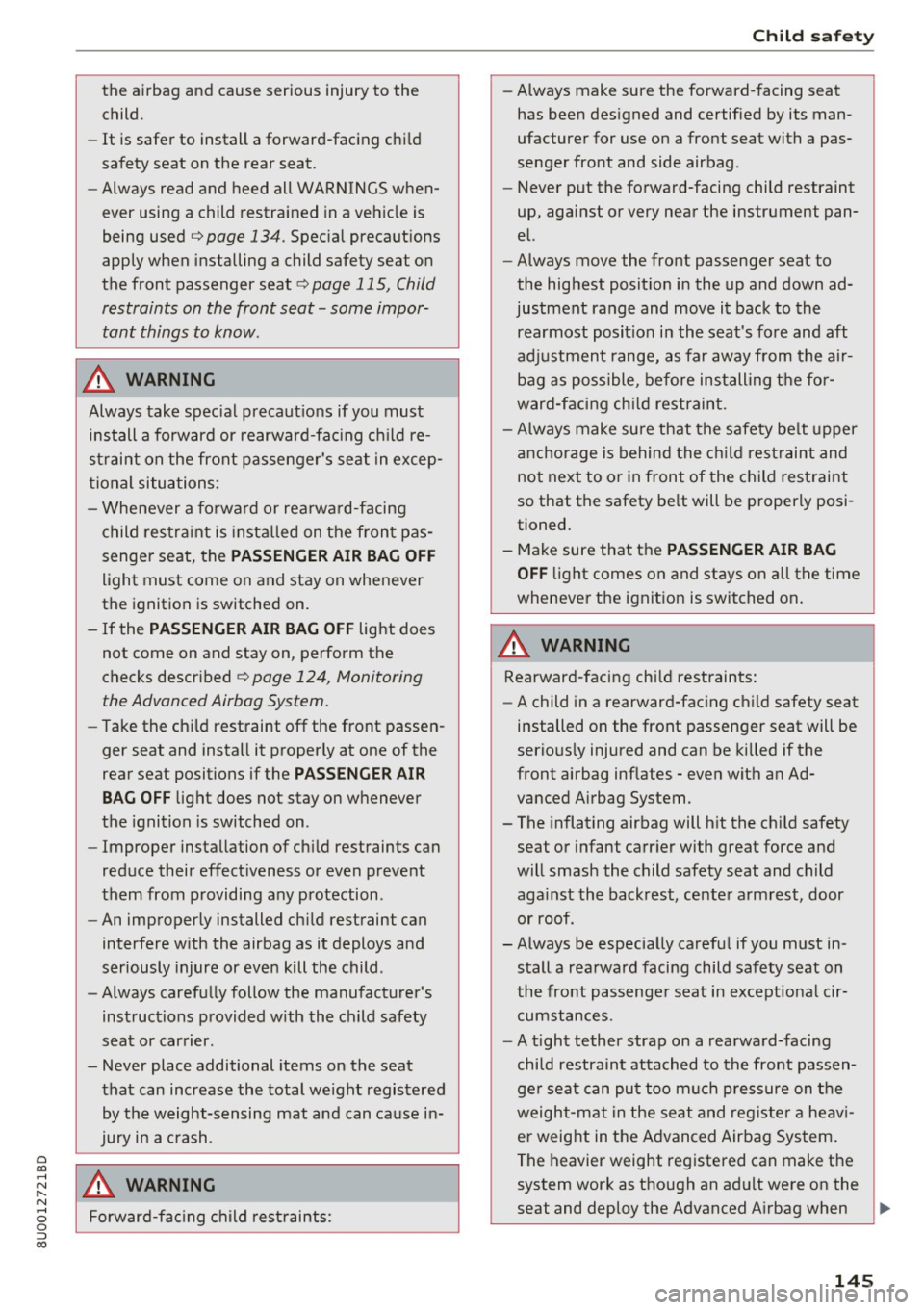
0 co ......
"' ,....
"' ...... 0 0 :::,
00
the airbag and cause serious injury to the
child.
- It is safer to install a forward-facing child
safety seat on the rear seat.
- Always read and heed all WARNINGS when
ever using a child restrained in a vehicle is
being used¢
page 134. Special precautions
apply when installing a child safety seat on
the front passenger seat ¢
page 115, Child
restraints on the front seat- some impor
tant things to know .
A WARNING
Always take special precaut ions if you must
install a forward or rearward-fac ing ch ild re
straint on the front passenger's seat in excep
tional situations:
- Whenever a forward or rearward-facing
child restraint is installed on the front pas
senger seat, the
PA SSENGER AIR BAG OFF
light must come on and stay on whenever
the ignition is switched on.
- If the PASSENGER AIR BAG OFF light does
not come on and stay on, perform the
checks described ¢
page 124, Monitoring
the Advanced Airbag System.
- Take the ch ild restraint off the front passen
ger seat and install it properly at one of the
rear seat positions if the
P AS SEN GER AIR
B AG OFF
light does not stay on whenever
the ignition is switched on .
- Improper installation of ch ild restraints can
reduce their effect iveness or even prevent
them from providing any protection .
- An improperly installed ch ild restraint can
interfere w ith the airbag as it deploys and
seriously injure or even kill the child .
- Always carefully follow the manufacturer's
instructions provided w ith the child safety
seat or carrier.
- Never place additional items on the seat
that can increase the total weight registered by the weight-sensing mat and can cause in
jury in a c rash.
A WARNING
Forward-fac ing child rest raints :
-
Child safety
-Always make sure the forward-facing seat
has been designed and certified by its man
ufacturer for use on a front seat with a pas
senger front and side airbag .
- Never put the forward-facing child restraint
up, against or very near the instrument pan
el.
- Always move the front passenger seat to
the highest posit ion in the up and down ad
justment range and move it back to the
rearmost posit ion in the seat's fore and aft
ad justment range, as far away from the air
bag as possible, before installing the for
ward-facing ch ild restraint.
- Always make sure that the safety be lt upper
anchorage is behind the ch ild rest raint and
not next to or in front of the child restraint
so that the safety be lt will be properly posi
tioned.
- Make sure that the
PASSENGER AIR BAG
OFF
li ght comes on and stays on all the time
wheneve r the ignit ion is switched on .
_& WARNING
-Rearward-facing ch ild restraints:
- A child in a rearward-facing child safety seat
installed on the front passenger seat will be
serious ly injured and can be killed if the
front airbag inflates -even with an Ad
vanced Airbag System.
- The inflating airbag will h it the ch ild safety
seat or infant carr ier with great force and
will smash the child safety seat and child aga inst the backrest, center armrest, door
or roof .
- Always be especia lly careful if you must in
stall a rearward facing child safety seat on
the front passenge r seat in except iona l cir
cumstances.
- A t igh t tether strap on a rearwa rd-facing
child restraint attached to the front passen
ge r seat can put too m uch p ressure on the
weight-m at in the seat and reg ister a heav i
er weight in the Advanced Airbag System .
The heavier weight reg istered can make the
system work as though an ad ult were on the
seat and deploy the Advanced A irbag when
Ill>
145
Page 148 of 230
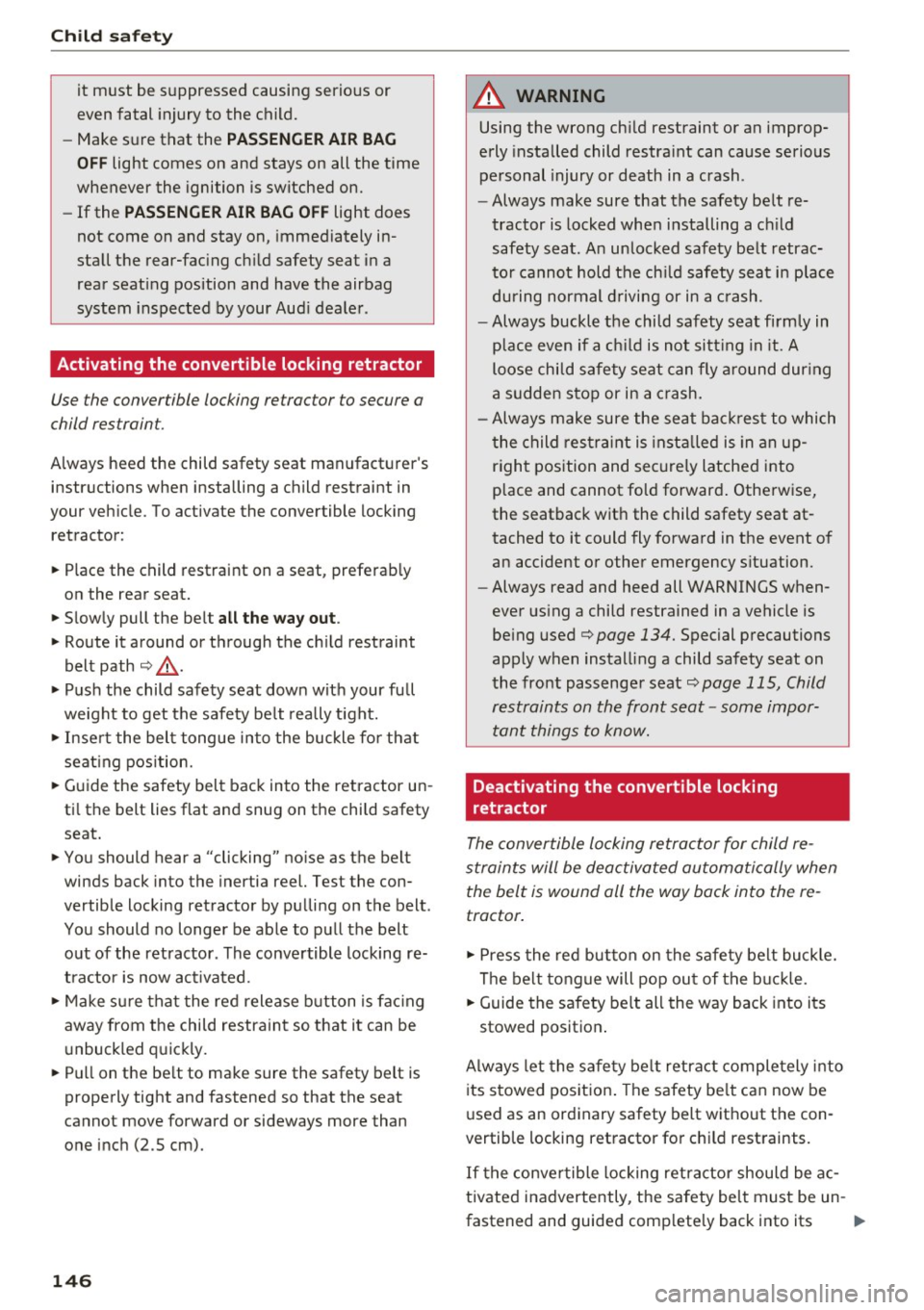
Child safety
it must be suppressed causing serious or
even fatal injury to the child.
- Make sure that the
PASSENGER AIR BAG
OFF
light comes on and stays on all the time
whenever the ignition is switched on.
- If the
PASSENGER AIR BAG OFF light does
not come on and stay on, immediately in
stall the rear-facing child safety seat in a
rear seating position and have the airbag
system inspected by your Audi dealer .
Activating the convertible locking retractor
Use the convertible locking retractor to secure a
child restraint.
Always heed the child safety seat manufacturer's
instructions when installing a child restraint in
your vehicle. To activate the convertible locking
retractor:
~ Place the child restraint on a seat, preferably
on the rear seat.
~ Slowly pull the belt all the way out.
~ Route it around or through the child restraint
belt path
~ &_ .
~ Push the child safety seat down with your full
weight to get the safety belt really tight.
~ Insert the belt tongue into the buckle for that
seating position.
~ Guide the safety belt back into the retractor un
til the belt lies flat and snug on the child safety
seat.
~ You should hear a "clicking" noise as the belt
winds back into the inertia reel. Test the con
vertible locking retractor by pulling on the belt .
You should no longer be able to pull the belt
out of the retractor . The convertible locking re
tractor is now activated.
~ Make sure that the red release button is facing
away from the child restraint so that it can
be
unbuckled quickly.
~Pullon the belt to make sure the safety belt is
properly tight and fastened so that the seat
cannot move forward or sideways more than
one inch (2 .5 cm).
146
A WARNING
-
Using the wrong child restraint or an improp-
erly installed child restraint can cause serious
personal injury or death in a crash .
- Always make sure that the safety belt re
tractor is locked when installing a child
safety seat . An unlocked safety belt retrac
tor cannot hold the child safety seat in place
during normal driving or in a crash.
-Always buckle the child safety seat firmly in
place even if a child is not sitting in it. A
loose child safety seat can fly around during
a sudden stop or in a crash.
- Always make sure the seat backrest to which
the child restraint is installed is in an up
right position and securely latched into
place and cannot fold forward. Otherwise,
the seatback with the child safety seat at
tached to it could fly forward in the event of
an accident or other emergency situation.
- Always read and heed all WARNINGS when
ever using a child restrained in a vehicle is
being used
c> page 134. Special precautions
apply when installing a child safety seat on
the front passenger seat
~ page 115, Child
restraints on the front seat -some impor
tant things to know.
· Deactivating the convertible locking
retractor
The convertible locking retractor for child re
straints will be deactivated automatically when
the belt is wound all the way back into the re
tractor.
~ Press the red button on the safety belt buckle.
The belt tongue will pop out of the buckle.
~ Guide the safety belt all the way back into its
stowed position.
Always let the safety belt retract completely into
its stowed position. The safety belt can now be
used as an ordinary safety belt without the con
vertible locking retractor for child restraints.
If the convertible locking retractor should be ac
tivated inadvertently, the safety belt must be un-
fastened and guided completely back into its .,.
Page 149 of 230

0 co ......
"' ,....
"' ...... 0 0 :::,
00
stowed position to deactivate this feature. If the
convertible locking retractor is not deactivated,
the safety belt w ill gradually become tighter and
uncomfortable to wear.
_&. WARNING
Improperly installed child safety seats in
crease the risk of serious personal injury and
death in a collision.
- Never unfasten the safety belt to deactivate
the convert ible locking retractor for child re
straints while the vehicle is moving. You
would not be restrained and could be seri o usly injured in an accident.
- Always read and heed all WARNINGS when
ever using a child restrained in a veh icle is
being used~
page 134. Specia l precautions
apply when installing a child safety seat on
the front passenger seat
~ page 115, Child
restraints on the front seat -some impor
tant things to know.
LATCH system (lower
anchorages and tethers
for children)
Child Restraint System anchors and how
are they related to child safety
To prov ide a simpler and more practicable way to
attach the child restra int on the vehicle seat,
F edera l regulat ions require specia l lower ancho
r ages in vehicles and devices on new child re
straints to attach to the vehicle anchorages.
I n the United States, the combination of the
tether anchorages and the lowe r anchorages is
now genera lly called the LA TC H system for
" L ower Anchorages and Tethers for C hildren" . In
Canada, the terms "top tether" with "lower uni
versal anchorages" (or "lower un iversal anchor
age bars") are used to describe the system.
In other countries the term "ISO FIX" is used to
describe the lower anchorages .
Forward-facing child res tra ints man ufactu red af
ter September 1, 1999, are required by U.S. fed
eral regulations to comply with new child head
movement performance requirements. These
Ch ild safety
new per formance requirements make a tether
necessary on most new chi ld seats.
Installing a ch ild rest raint that requires a top
tether without one can seriously impa ir the per
formance of the child restraint and its ab ility to
protect the child in a co llision. Installing a child
restra int that requires a top tether without the
top tether may be a violat ion of state law.
Child restraint manufacturers offer LATCH lowe r
anchorages on their child seats with hook-on or
push-on connectors attached to adjustable
straps.
In addition to the LATCH lower anchorages, these
child restraint systems usua lly require the use of
tether straps to help keep the child restra int
firmly in p lace.
_&. WARNING
Improper installation of child restra ints w ill
i ncrease the risk of injury and death in a
crash.
- Always follow the instructions prov ided by
the man ufacturer of the ch ild restraint you
inte nd to install in your vehicle.
- Never i nstall a chi ld restraint without a
proper ly attached top tether strap if the
child restraint manufacture r's instructions
require the top tether strap to be used.
-
- Improper use of child restraint LATCH lower
anchorage points can lead to injury in a col li
sion. The LA TC H l ower anchorage points are
des igned to w ithstand only those loads im
posed by correctly fitted child restraints .
- Never mo unt two child res traint systems on
one LA TC H lower anchorage point.
- Never secure or at tach any luggage o r othe r
item to the LA TC H l ower anchorages.
147
Page 150 of 230
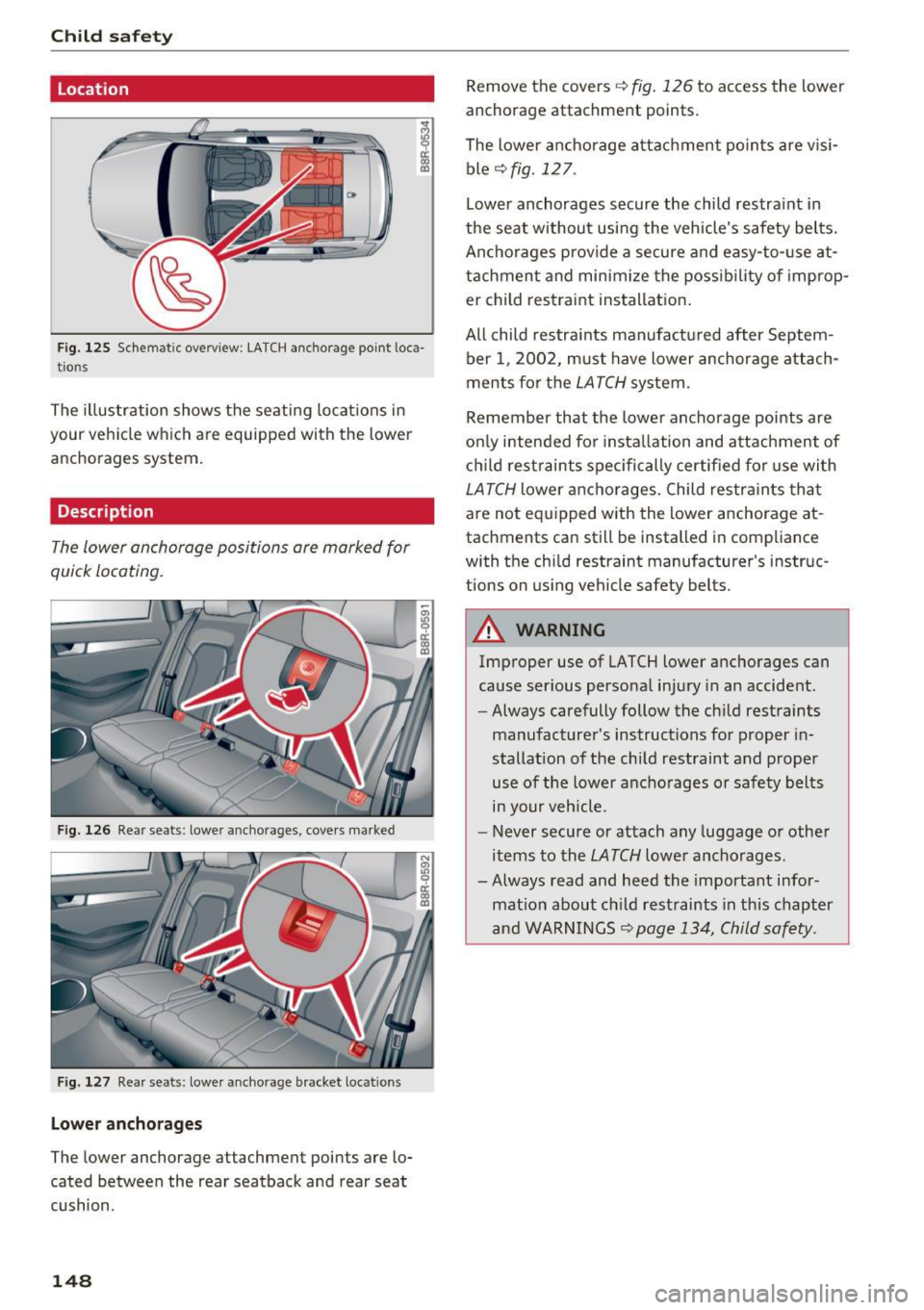
Child safety
Location
;
a: ex, a,
Fig. 125 Schem atic overv iew : LA TCH anchorage point loca
tio ns
The illustration shows the seating locat ions in
your vehicle w hich are equipped with the lower
anchorages system.
Description
The lower anchorage positions are marked for
quick locating.
F ig. 126 Re ar s eats: lowe r an cho rages, covers ma rked
F ig . 127 Re ar seats: lowe r an cho rage b racket locatio ns
Lowe r ancho rage s
The lower anchorage attachment points are lo
cated between the rear seatback and rear seat
cushion .
148
Remove the covers c::> fig. 126 to access the lower
anchorage attachment po ints.
The lower anchorage a ttachment po in ts are v is i
ble
c::> fig. 12 7 .
Lower anchorages secure the child restra int in
the seat without using the vehicle's safety bel ts.
Ancho rages prov ide a secure and easy-to- use at
tachment and minimize the possib ility of improp
er child restraint installat ion .
All child restraints manufact ured after Septem
ber 1 , 2002, must have lower anchorage attach
ments for t he
LATCH system.
Remember that the lower ancho rage points are
on ly intended for insta llation and attachment of
ch ild rest raints spec ifically certif ied for use wi th
LATCH lower anchorages. Child restraints that
are not eq uipped with the lower anchorage at
tachments can still be installed in compliance
with the chi ld restraint manufacturer's instruc
tions on us ing vehicle safety belts.
A WARNING
Improper use of LATCH lower anchorages can
cause ser ious persona l injury in an accide nt.
- Always carefully follow the ch ild restraints
manufacturer's instructions for proper in
stallation of the child restraint and proper
use of the lower ancho rages or safety belts
in your vehicle.
- Never secure or attach any luggage or othe r
items to the
LATCH lower anchorages.
-Always read and heed the important infor mat ion about c hild restraints in this chapter
and WARN INGS
c::> page 134, Child safety .
Page 151 of 230
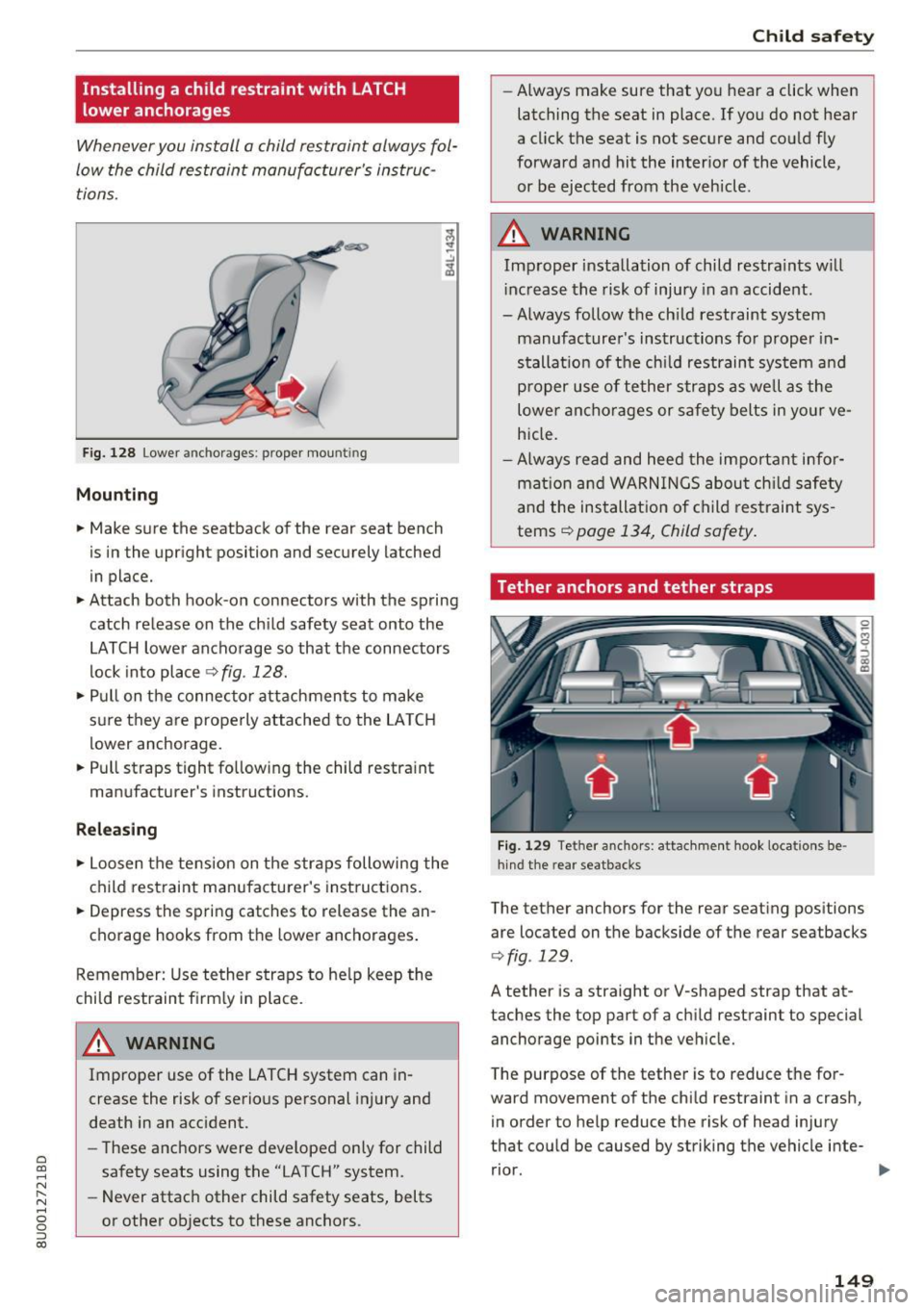
a
co
...... N r--. N
'"' 0 0 ::, co
Installing a child restraint with LATCH
lower anchorages
Whenever you install a child restraint always fol
low the child restraint manufacturer's instruc
tions.
Fig. 128 Lower anchorages: proper mount ing
Mounting
.,. Make sure the seatback of the rear seat bench
is in the upright position and securely latched
in place.
.,. Attach both hook-on connectors with the spring
catch release on the child safety seat onto the
LATCH lower anchorage so that the connectors
lock into place
¢ fig. 128 .
.,. Pull on the connector attachments to make
sure they are properly attached to the LA TC H
lower anchorage .
.,. Pull straps tight fo llowing the child restraint
manufacturer's instructions.
R ele asing
.,. Loosen the tension on the straps following the
child restraint manufacturer's instructions.
.,. Depress the spring catches to release the an
chorage hooks from the lower anchorages .
Remember: Use tether straps to he lp keep the
child restraint firmly in place.
A WARNING
Improper use of the LATCH system can in
crease the risk of serious personal injury and
death in an accident.
- These anchors were deve loped only for child
safety seats using the "LATCH" system.
- Never attach other child safety seats, belts
or other objects to these anchors.
Ch ild sa fety
- Always make sure that you hear a click when
latching the seat in place . If yo u do not hear
a cl ick the seat is not secure and could fly
forward and hit the inter ior of the vehicle,
or be ejected from the veh icle.
A WARNING
-Improper installation of child restra ints w ill
i ncrease the risk of injury in an accident.
-Always follow the ch ild restraint system
manufacturer's instructions for proper in
stallat ion of the chi ld restraint system a nd
p roper use of tether straps as well as the
lowe r ancho rages or safety belts in yo ur
ve
hicle.
- Always read and heed the important info r
mat ion and WARN INGS abou t ch ild safety
a nd the installat ion of child restraint sys
tems¢
page 134, Child safety.
Tether anchors and tether straps
Fig. 129 Tether ancho rs: attac hmen t hook locatio ns be
hind the rear sea tbacks
The tether anchors for the rear seating positions
are located on the backside of the rear seatbacks
¢ fig . 129 .
A tether is a straight or V-shaped strap that at
taches the top part of a child restraint to special
anchorage points in the veh icle.
T he purpose of the tether is to reduce the for
ward movement of the chi ld restraint in a crash,
in order to help reduce the risk of head injury
that could be caused by striking the vehicle inte-
rior.
liJ,
149
Page 152 of 230
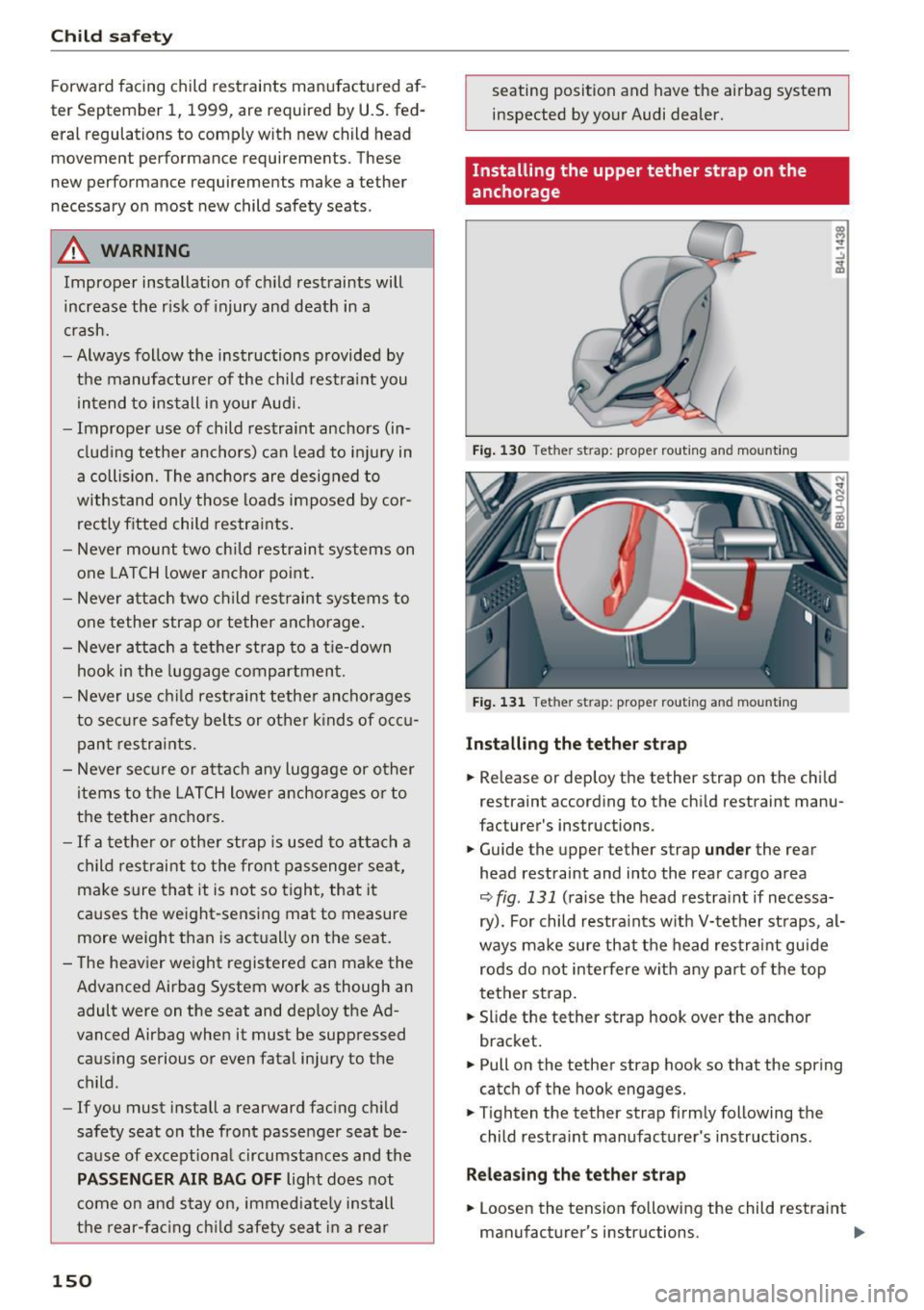
Child safety
Forward facing child restraints manufactured af
ter September 1, 1999, are required by U.S. fed
eral regulations to comply with new child head
movement performance requirements. These
new performance requirements make a tether
necessary on most new child safety seats.
A WARNING
Improper installation of child restraints will
increase the risk of injury and death in a
crash.
- Always follow the instructions provided by
the manufacturer of the child restraint you
intend to install in your Audi.
- Improper use of child restraint anchors (in
cluding tether anchors) can lead to injury in
a collision. The anchors are designed to
withstand only those loads imposed by cor
rectly fitted child restraints.
- Never mount two child restraint systems on
one LATCH lower anchor point.
- Never attach two child restraint systems to
one tether strap or tether anchorage.
- Never attach a tether strap to a tie-down
hook in the luggage compartment.
- Never use child restraint tether anchorages
to secure safety belts or other kinds of occu pant restraints.
- Never secure or attach any luggage or other
items to the LATCH lower anchorages or to
the tether anchors.
- If a tether or other strap is used to attach a
child restraint to the front passenger seat,
make sure that it is not so tight, that it
causes the weight-sensing mat to measure
more weight than is actually on the seat.
- The heavier weight registered can make the Advanced Airbag System work as though an
adult were on the seat and deploy the Ad
vanced Airbag when it must be suppressed
caus ing serious or even fatal injury to the
child .
- If you must install a rearward facing child
safety seat on the front passenger seat be
cause of exceptional circumstances and the
PASSENGER AIR BAG OFF light does not
come on and stay on, immediately install
the rear-facing child safety seat in a rear
150
seating position and have the airbag system
inspected by your Audi dealer.
Installing the upper tether strap on the
anchorage
Fig. 130 Tether strap: proper routing and mounting
Fig. 131 Tether strap: proper rout ing and mount ing
Installing the tether strap
.,. Release or deploy the tether strap on the child
restraint according to the chi ld restraint manu
facturer's instructions.
.,. Guide the upper tether strap
under the rear
head restraint and into the rear cargo area
r:::;, fig. 131 (raise the head restraint if necessa
ry). For child restraints with V-tether straps, al
ways make sure that the head restraint guide
rods do not interfere with any part of the top
tether strap.
.,. Slide the tether strap hook over the anchor
bracket.
.,. Pull on the tether strap hook so that the spring
catch of the hook engages .
.,. Tighten the tether strap f irmly following the
child restraint manufacturer's instructions.
Releasing the tether strap
.,. Loosen the tension following the child restraint
manufacturer's instructions.
II>
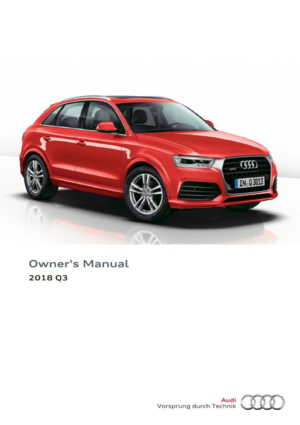 1
1 2
2 3
3 4
4 5
5 6
6 7
7 8
8 9
9 10
10 11
11 12
12 13
13 14
14 15
15 16
16 17
17 18
18 19
19 20
20 21
21 22
22 23
23 24
24 25
25 26
26 27
27 28
28 29
29 30
30 31
31 32
32 33
33 34
34 35
35 36
36 37
37 38
38 39
39 40
40 41
41 42
42 43
43 44
44 45
45 46
46 47
47 48
48 49
49 50
50 51
51 52
52 53
53 54
54 55
55 56
56 57
57 58
58 59
59 60
60 61
61 62
62 63
63 64
64 65
65 66
66 67
67 68
68 69
69 70
70 71
71 72
72 73
73 74
74 75
75 76
76 77
77 78
78 79
79 80
80 81
81 82
82 83
83 84
84 85
85 86
86 87
87 88
88 89
89 90
90 91
91 92
92 93
93 94
94 95
95 96
96 97
97 98
98 99
99 100
100 101
101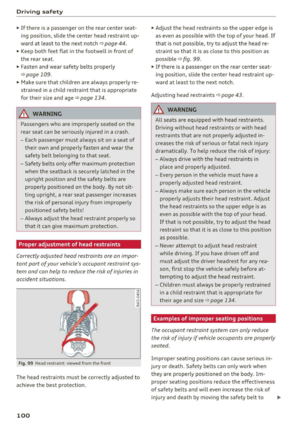 102
102 103
103 104
104 105
105 106
106 107
107 108
108 109
109 110
110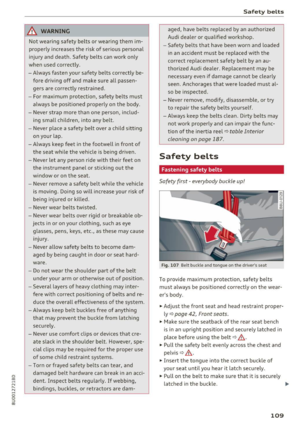 111
111 112
112 113
113 114
114 115
115 116
116 117
117 118
118 119
119 120
120 121
121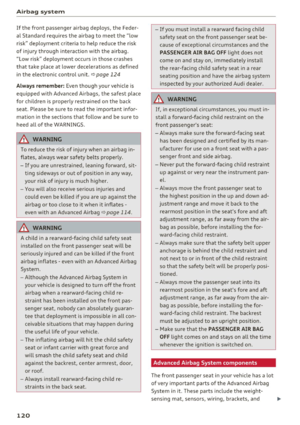 122
122 123
123 124
124 125
125 126
126 127
127 128
128 129
129 130
130 131
131 132
132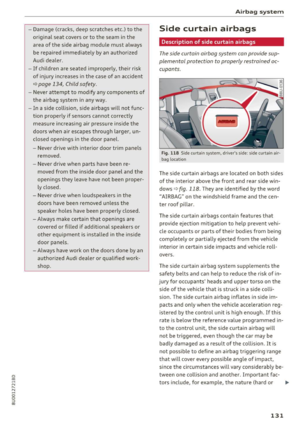 133
133 134
134 135
135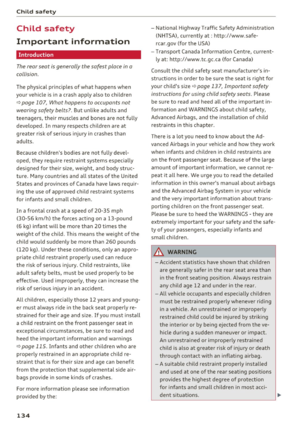 136
136 137
137 138
138 139
139 140
140 141
141 142
142 143
143 144
144 145
145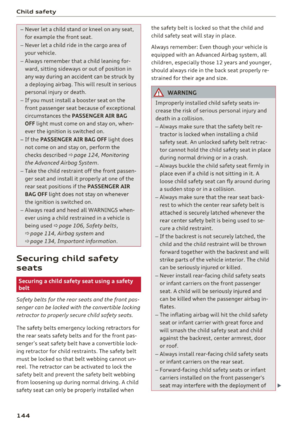 146
146 147
147 148
148 149
149 150
150 151
151 152
152 153
153 154
154 155
155 156
156 157
157 158
158 159
159 160
160 161
161 162
162 163
163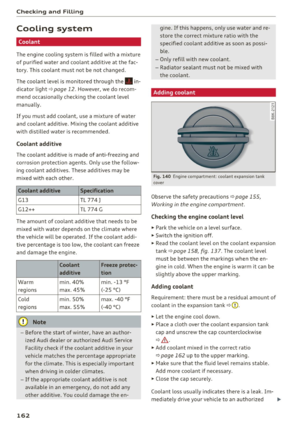 164
164 165
165 166
166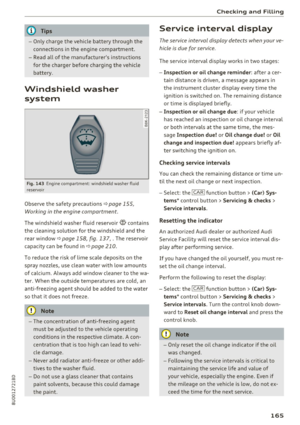 167
167 168
168 169
169 170
170 171
171 172
172 173
173 174
174 175
175 176
176 177
177 178
178 179
179 180
180 181
181 182
182 183
183 184
184 185
185 186
186 187
187 188
188 189
189 190
190 191
191 192
192 193
193 194
194 195
195 196
196 197
197 198
198 199
199 200
200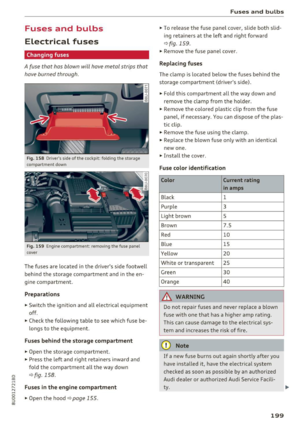 201
201 202
202 203
203 204
204 205
205 206
206 207
207 208
208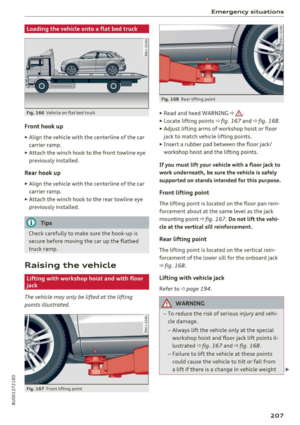 209
209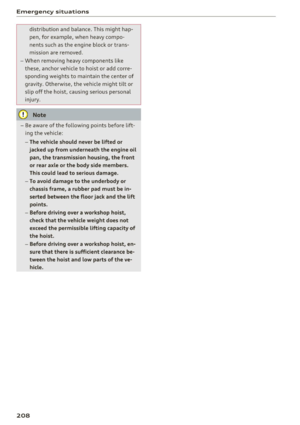 210
210 211
211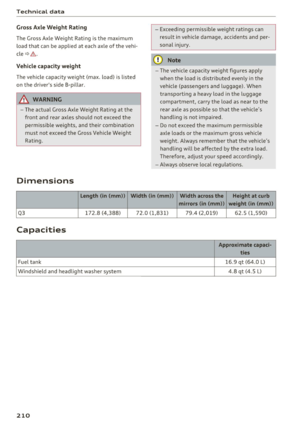 212
212 213
213 214
214 215
215 216
216 217
217 218
218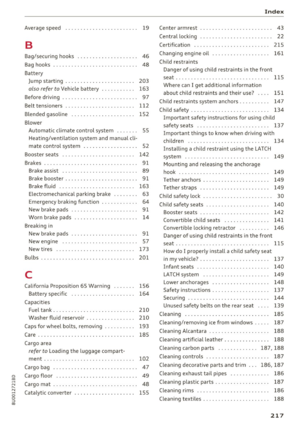 219
219 220
220 221
221 222
222 223
223 224
224 225
225 226
226 227
227 228
228 229
229






